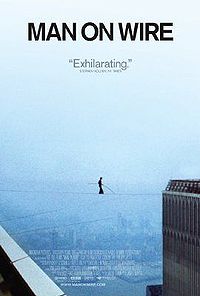Man On Wire
 The anonymous “walker” in Let The Great World Spin obviously is inspired by Philippe Petit, the French high-wire artist who walked between the Twin Towers in New York in 1974. Anyone interested in that extraordinary act of artistic daredevilry might want to see the 2008 documentary about the event directed by James Marsh, which won all sorts of film awards.
The anonymous “walker” in Let The Great World Spin obviously is inspired by Philippe Petit, the French high-wire artist who walked between the Twin Towers in New York in 1974. Anyone interested in that extraordinary act of artistic daredevilry might want to see the 2008 documentary about the event directed by James Marsh, which won all sorts of film awards.
Also, the epigraph for McCann’s novel comes from Aleksandar Hemon‘s novel The Lazarus Project. Hemon’s life and work are fascinating. Music lovers will appreciate this interview with Hemon about the music he loves (and listened to while writing The Lazarus Project.) “I cannot live or write without music,” he says.
Here’s some of what Hemon listened to while working on the novel, which is about a Bosnian-American journalist trying to discover what happened a century before his time to an Eastern European immigrant Jew who ends up in Chicago… and being killed by the Chicago chief of police: “I wrote substantial parts of The Lazarus Project in Sarajevo in the summer of 2005,” Hemon says. “I had my iPod on hand, but when I drove around Bosnia I listened only to a couple of CDs. One of them was Nick Cave’s “Murder Ballads” (the other one was Pet Shop Boys’ “Introspective”), which I listened to for hundreds of miles on end. Listening to “Murder Ballads” driving through the night in the murder land is quite an experience in itself, but nothing tops “Stagger Lee” in the purity of the audible evil. Blixa Bargeld’s screech at the end of the song, no doubt recorded in the deepest pits of hell, was — and still is — literally breathtaking. The knowledge of evil I gleaned from “Stagger Lee” and “Murder Ballads” was quite useful in writing The Lazarus Project.”